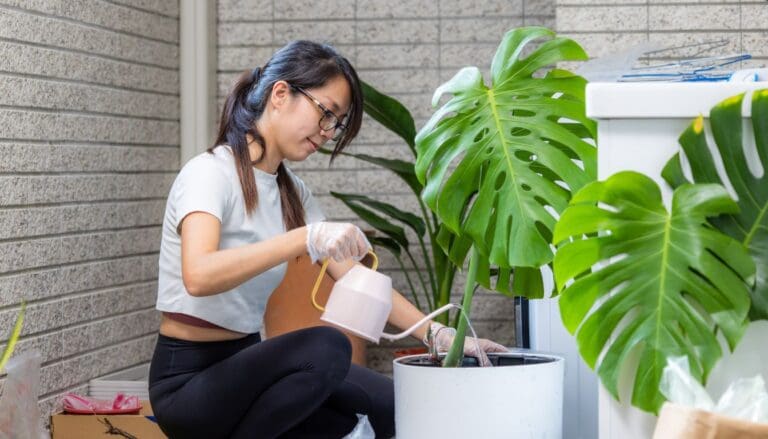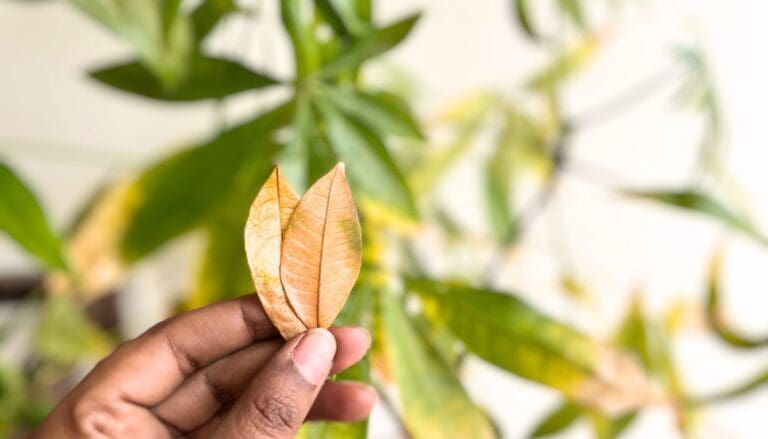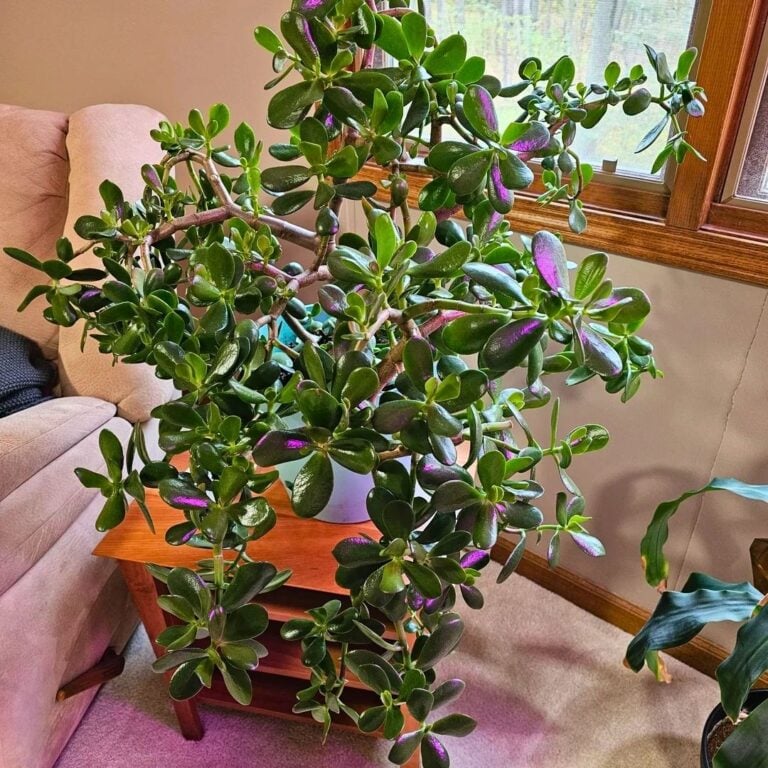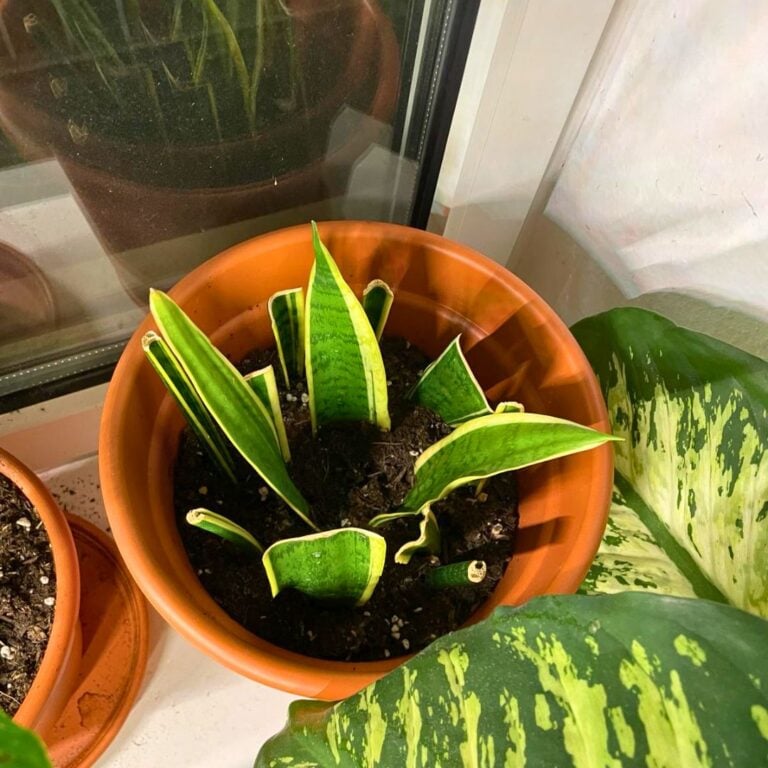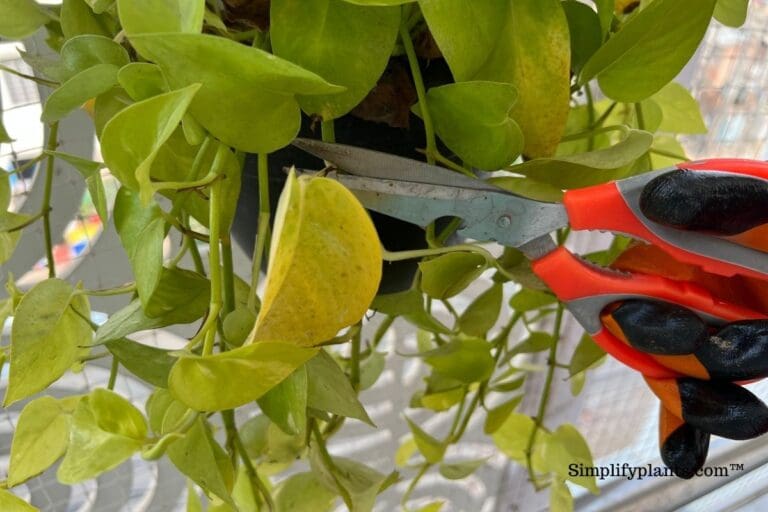8 Houseplant Fixes You Can Do in Under 10 Minutes
Sometimes my houseplants start looking a little sad, but I don’t always have hours to fix them. I’ve learned that with just a few quick tricks, I can keep my plants healthy and happy without spending my whole day on plant care.
Honestly, I’m always looking for easy ways to deal with small houseplant problems fast. When my plants look their best, my whole space just feels brighter.
Please note: Simplify Plants is reader-supported. As an Amazon Associate, I earn from qualifying purchases made by our readers with no extra cost added to you all! Some links in the post are affiliate links and I get a commission from purchases made through links in the post.
1) Prune yellow leaves on your monstera

When I spot yellow leaves on my monstera, I grab a clean pair of scissors right away. Removing yellow or dying leaves helps the plant focus its energy on new growth.
I look for leaves that are more yellow than green. If they’re drooping or crispy, I snip them off right where the stem meets the main stalk.
I always use clean scissors or garden shears to avoid spreading bacteria. After pruning, my monstera looks fresher and the healthy leaves stand out more.
I try not to go overboard—removing too many leaves at once can stress the plant. While I’m at it, I check the soil to make sure I’m not overwatering, since that’s a common cause of yellow leaves.
Pruning is quick and rarely takes more than 10 minutes. It really does brighten up my monstera and my living room.
2) Repot a small succulent into fresh soil
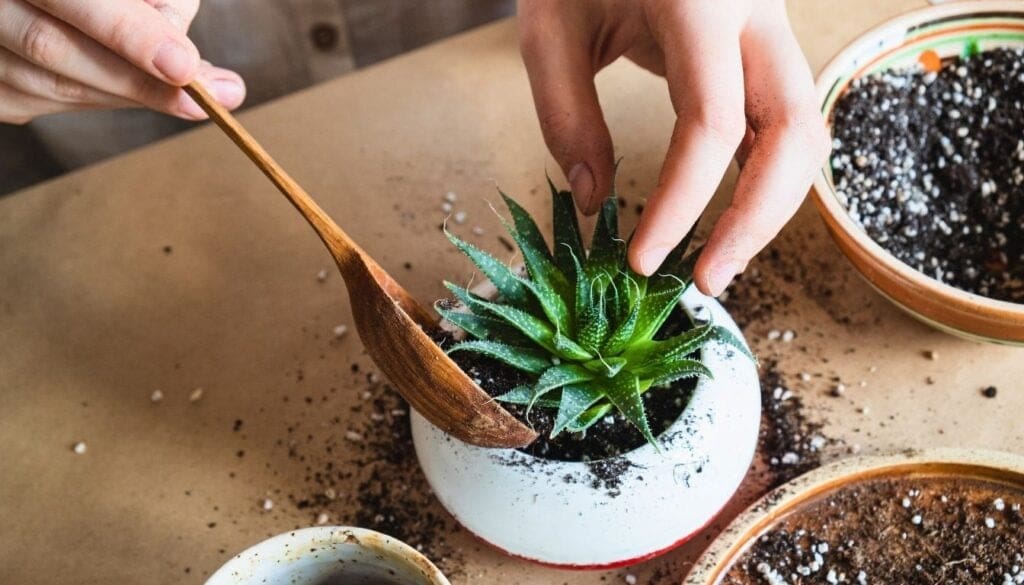
I grab my small succulent and a clean pot that’s just a bit bigger than the old one. Fresh soil is key for a healthy plant, so I use a mix made for succulents or cacti—it drains better and helps prevent rot.
Gently, I tip the plant out of its old pot. I knock off any clumps of old soil stuck to the roots, and if I spot any mushy or blackened roots, I trim them with clean scissors.
Next, I fill the bottom of the new pot with fresh soil. I set my succulent in the center and sprinkle more soil around it until the roots are covered.
I press the soil down gently so it holds the plant in place but doesn’t suffocate the roots. After repotting, I wait a day before watering—this helps the roots settle and lowers the chance of rot.
A quick repot in fresh soil can make a huge difference for my succulent’s health.
3) Wipe dust off fiddle leaf fig leaves

I always notice how quickly dust builds up on my fiddle leaf fig leaves. Too much dust blocks sunlight and just makes the plant look dull.
When I clean my fiddle leaf fig, I use a soft, damp cloth. I gently hold each leaf with one hand and use the other to wipe away the dust, making sure to clean both the top and bottom.
I avoid using any harsh cleaners. Just water is enough for this quick job. If there are sticky spots, I’ll use a tiny drop of mild soap, but I always rinse it off.
It usually takes less than 10 minutes to clean all the leaves. My plant looks brighter, and honestly, the leaves seem shinier right after.
4) Mist your orchids lightly with water

When my orchids look a bit dry or wilted, I know it’s time for a quick mist. Orchids love humidity, but their roots don’t like to be soaked.
I use a small spray bottle with room temperature water. I gently mist the leaves and aerial roots—just a few sprays, nothing crazy.
Misting adds moisture to the air around the plant. This keeps my orchid happy, especially when it’s winter or the heat’s blasting.
I avoid spraying the flowers because too much water can cause rot. A light misting every few days is enough. I check if the room feels dry before misting again.
It’s quick, easy, and I swear my orchid looks fresher right after.
5) Rotate your snake plant for even light

I always make sure to rotate my snake plant every week or two. Snake plants grow toward the light, so if I leave mine in one spot too long, it starts leaning or looking a bit off.
By turning the pot just a quarter turn, I help every side get the same amount of sunlight. Each leaf stands taller and looks healthier.
Rotating only takes a few seconds, but I notice a big difference in how straight and full my plant looks. Balanced light helps all the leaves stay green and strong.
If my snake plant is near a window, one side might get more sun, so I just give it a little spin. That’s all it takes to keep it from growing lopsided.
Even light also helps prevent dark spots and keeps growth steady. I like knowing my snake plant looks great from every angle.
This quick fix is easy to remember. Every time I water, I just rotate the pot a bit.
6) Check and adjust soil moisture with a finger test

I always use the finger test to check if my houseplants need water. It’s quick and tells me exactly what my plant needs.
All I do is stick my finger about an inch into the soil. If it feels dry, it’s time to water. If it’s still damp or wet, I hold off.
Overwatering can hurt my plants, so I want to avoid it. This simple test works for most houseplants and helps me catch problems early, like soil that’s staying wet too long or drying out too fast.
If the soil is really dry, I water slowly so it can soak in. If it’s damp, I check again in a day or two.
I like how fast and easy this is. No fancy tools, no guessing—just my finger and a few seconds.
7) Add diluted fertilizer to your peace lily

I like to keep my peace lily looking healthy. Every few weeks, I give it a bit of diluted fertilizer.
I always mix the liquid fertilizer with water, about half the strength shown on the label. That’s usually plenty for my plant.
I pour the mixture onto the soil, not the leaves, to avoid burning. I use a small cup or watering can so I don’t overdo it.
Too much fertilizer can burn the roots or cause yellow leaves, so I’m careful. When I’m done, I usually notice my peace lily’s leaves stay shiny and green, and the flowers just seem to last longer.
I only fertilize during the growing season—spring and summer. In fall and winter, I cut back.
Using diluted fertilizer is fast and simple. It keeps my peace lily strong and happy.
8) Remove dead flowers from an African violet
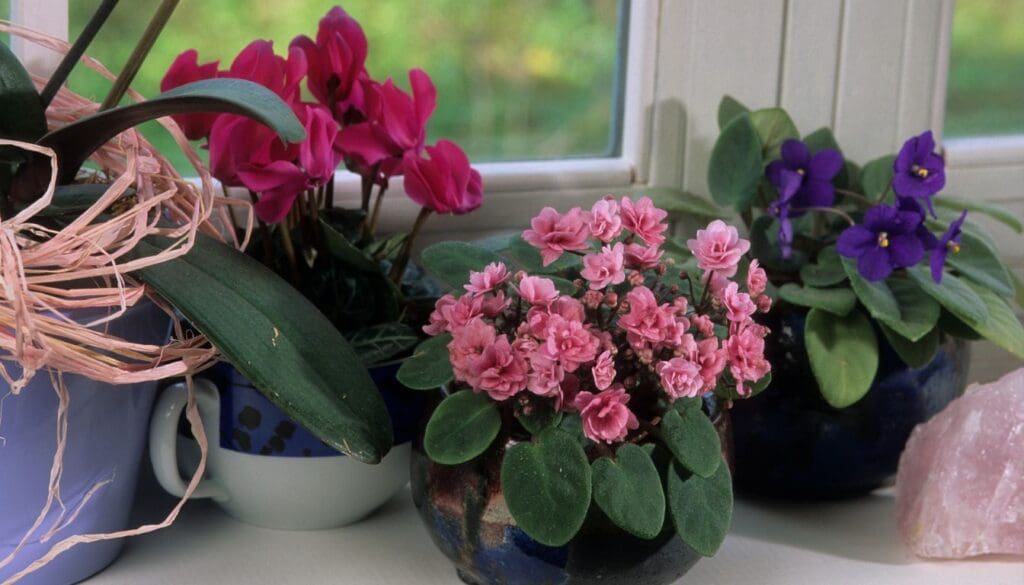
When my African violet starts to look a little sad, I check for dead flowers. Dead blooms can make the plant look messy and slow down new growth.
I use my fingers or small scissors to gently pinch or snip off the faded flowers. I always try to remove the entire flower, including the stem.
This only takes a couple of minutes but really helps keep the plant healthy. Removing dead flowers tells the plant to focus on growing new leaves and buds.
I make sure to be gentle so I don’t damage the soft leaves. If I do this regularly, my African violet looks fresh and full of new life.
Cleaning off dead flowers also prevents mold and other issues. It’s a simple way to help my plant shine on my windowsill!
Essential Tools for Fast Houseplant Care
Having the right tools nearby helps me keep my plants looking great with less effort. I like staying organized so I can fix plant problems quickly.
Must-Have Supplies
I always keep a few simple tools on hand for quick fixes. My must-haves include:
- Watering can with a narrow spout for precise watering
- Pruning scissors for trimming dead leaves and stems
- Spray bottle for misting leaves
- Soft cloth or microfiber towel for wiping dust
- Small trowel or spoon for adding soil
- Plant stakes for supporting droopy plants
- Fertilizer sticks for easy feeding
I keep these supplies together in one spot so I don’t waste time searching. Using the right tools helps me avoid hurting my plants and keeps my care routine simple.
Tips for Staying Organized
Honestly, I find it so much easier to care for my plants when my tools aren’t scattered everywhere. I just toss everything into a small basket or caddy—it’s nothing fancy, but it works.
That way, I can just grab it and move from plant to plant without hunting for anything. I also like to label bottles and scissors, so I don’t accidentally use the wrong thing.
Keeping a simple care log helps too, even if it’s just a quick note about when I last watered or fed my plants. It’s not perfect, but it helps me spot problems early and keeps me on track.
Frequently Asked Questions
Honestly, these little tricks save me time and keep my plants looking pretty good. Each answer here is something I actually do when I run into plant issues.
How can I quickly diagnose common issues with my indoor plants?
I look for signs like yellow leaves, drooping stems, or brown spots. If I see dust building up on leaves or roots that look crowded, that’s usually my cue to do something.
Sometimes, I just poke my finger in the soil to check if it’s too dry or needs a change. It’s not exactly scientific, but it works for me.
What are some rapid solutions for typical indoor plant problems?
If I spot yellow leaves, I just snip them off right then. When my succulent looks cramped, I’ll go ahead and repot it with fresh soil.
I wipe dust off my fiddle leaf fig’s leaves with a damp cloth—so simple, but it makes a difference. Rotating my snake plant helps all the sides catch some light, so nothing gets left out.
Can you suggest a simple care guide for various types of houseplants?
I only water my succulents when the soil feels bone dry. For my monstera, I keep it in bright, indirect light—direct sun just fries the leaves.
I mist my orchids lightly, but I’m careful not to soak the roots. Snake plants? I let the soil dry out almost all the way before watering again.
Where can I find a chart for basic houseplant care routines?
I usually check online—plant care blogs or gardening websites are full of good info. Printable charts are easy to find on Pinterest or even from local plant shops.
Most of those guides list water, light, and fertilizer needs, so they’re handy to keep around.
How do I fix yellowing leaves on my houseplant in a short time?
I grab clean scissors and prune any yellow leaves as soon as I spot them. Then I double-check the light and water situation.
If the soil’s soggy, I’ll let it dry out a bit—plants really don’t like sitting in wet feet.
Is there a way to identify and treat my plant’s problem using pictures?
Yes, I use phone apps and gardening websites where I can upload photos. Some of these plant care apps actually give instant feedback or suggestions just by looking at the picture.
It’s honestly pretty helpful when I’m not sure what’s going on with my plants. Sometimes the advice is spot-on, and other times, well, it gives me a place to start.
Recommended Garden Supplies
| Product Image | Our Recommended Gardening Supplies | Check Offers! |
|---|---|---|
Top Top
Top
Top
Top
Top
Top
Top
Top | rePotme Houseplant and Tropical Classic Potting Soil Mix | Check Offer On Amazon |
 Top
Top
Top
Top
Top
Top
Top
Top | Espoma Organic Indoor Plant Food | Check Offer On Amazon |
 Top
Top
Top
Top
Top
Top
Top
Top | GooingTop LED Grow Light 6000K Full Spectrum Clip Plant Growing Lamp | Check Offer On Amazon |
 Top
Top
Top
Top
Top
Top
Top
Top | Soil Moisture Meter | Check Offer On Amazon |
 Top
Top
Top
Top
Top
Top
Top
Top | Govee Hygrometer Thermometer, Bluetooth Enabled! | Check Offer On Amazon |
 Top
Top | LEVOIT Humidifiers for Large Room(Best For Plants) | Check Offer On Amazon |
 Top
Top
Top
Top
Top
Top
Top
Top | Upgraded DIY Automatic Drip Irrigation Kit, 15 Potted Houseplants Support | Check Offer On Amazon |
 Top
Top
Top
Top
Top
Top
Top
Top | Stainless Steel Heavy Duty Gardening Tool Set | Check Offer On Amazon |
 Top
Top
Top
Top
Top
Top
Top
Top | Bonide Insecticidal Soap | Check Offer On Amazon |
 Top
Top
Top
Top
Top
Top
Top
Top | Bonide 32 oz Spray Neem Oil for Organic Gardening | Check Offer On Amazon |
 Top
Top
Top
Top
Top
Top
Top
Top | Garden Safe Fungicide | Check Offer On Amazon |

